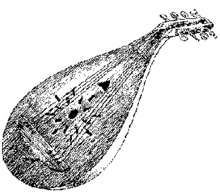Cobza

The cobza (also cobsa, kobuza, kobuz, coboz or koboz) is a multi-stringed instrument of the lute family of folk origin popular in Romanian, Moldovan and Hungarian folk music.
It is distinct from the Ukrainian kobza, an instrument of a different construction and origin.[1]
The Romanian cobza is metal-strung (although nylon-strung models exist, mostly in Hungary), and has a very short neck without frets, with a bent-back pegbox. The back is ribbed. It is usually double or triple strung, and often has a characteristic flat end clasp.
The cobza is played with a plectrum in elaborate and florid melodic passagework, and has a pick-guard similar to that of an oud. Its strings are widely spaced at the bridge to facilitate this technique. It has a soft tone, most often tuned to D-A-D-G (although tuning depends per style, region and player).[2]
The origins of the Romanian cobza are thought to be a local adaptation of the Persian barbat or Turkish oud, probably brought to the area by itinerant Romani musicians in the 15th century[3] (a Romani musician is called lăutar, literally lute-player). A cobza player specifically is called a cobzar.[4]
The Romanian-Hungarian cobza was also played by Ukrainian musicians in various music ensembles in the Bukovyna region in the mid war periods, being replaced totally by the mandolin and 4 stringed domra when this area became incorporated into the Ukrainian SSR.[5]
The name of the instrument comes from the Turkic "kopuz". [6]
References
- ↑ Gregory F. Barz, Timothy J. Cooley (eds.) (1997), Shadows in the Field: New Perspectives for Fieldwork in Ethnomusicology, Oxford University Press, New York, p. 187
- ↑ http://www.koboz.hu
- ↑ http://www.campin.me.uk/Music/Cobza/
- ↑ Viorel Cosma (1960), Figuri de Lautari, Musical Printing House, Bucharest, p. 230
- ↑ Mizynec, V. - Folk Instruments of Ukraine. Bayda Books, Melbourne, Australia, 1987 - 48с.
- ↑ http://stringedinstrumentdatabase.aornis.com/